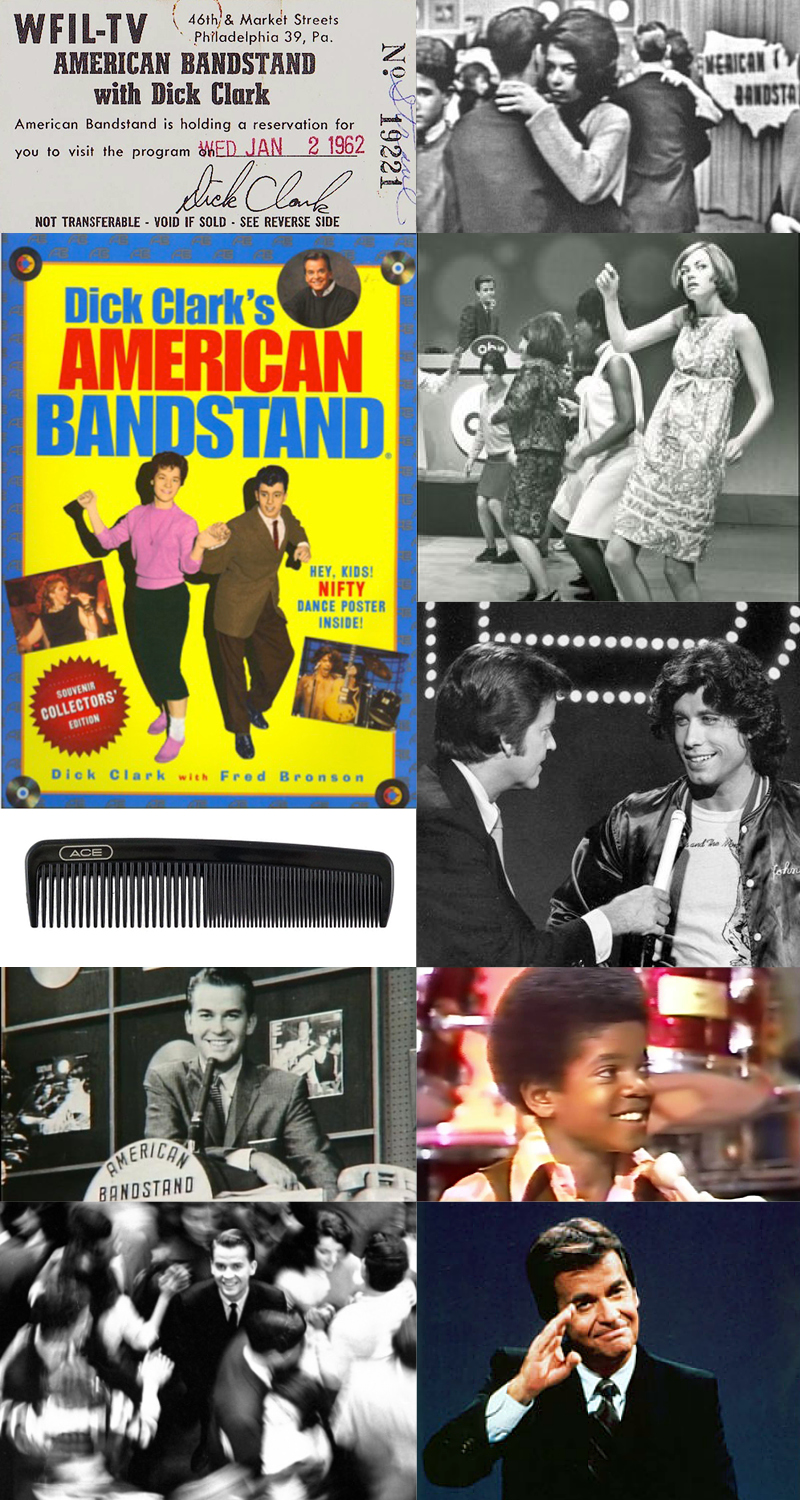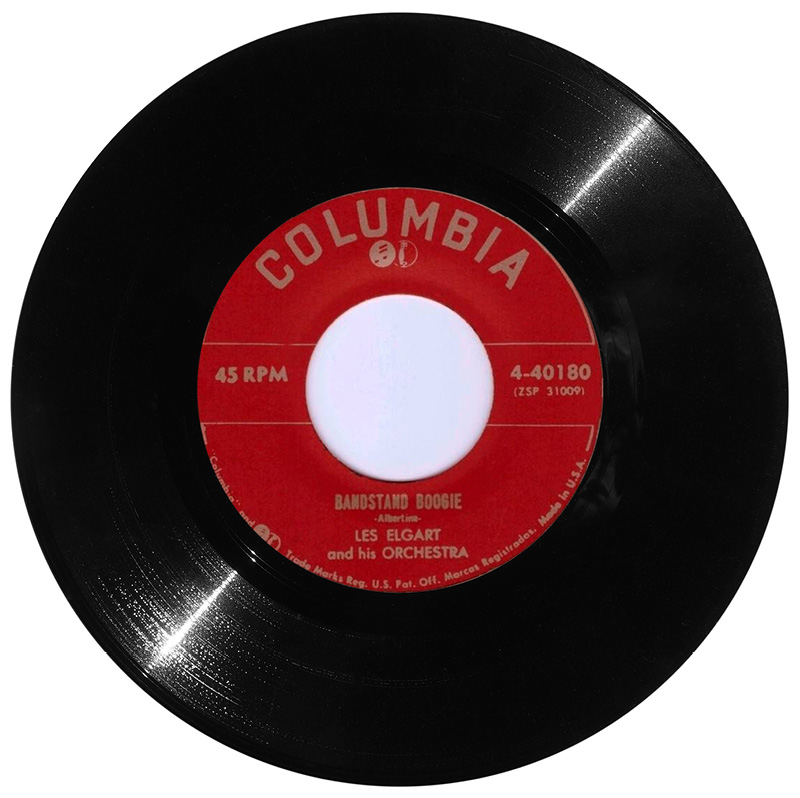“It’s got a good beat and you can dance to it”

(clockwise from lower left) Dick Clark was at the center of it all for decades; Dick in position on his show; Every male in the 50’s had to have an Ace comb in his back pocket; Dick Clark was a master at promotion; A show pass; Guys in suits and girls in dresses, that’s how it was done; Late 50’s boggie on afternoon TV; John Travolta Sept. 15, 1976; The start of Michael Jackson’s many appearances; Dick Clark’s typical sign off.
Ever have one of those days, when everything is clicking, and you just wanna dance? I do, thanks to the awesome work of my gang here at KHT. It’s an absolute blast for me to walk around the different plants, checking on your PIA (Pain in the @#$) Jobs, and chatting with the crews. With all the doors open, the sun shining in and the weather so nice, I find myself ‘dancin’ from building to building as we solve our customer’s problems. (yes, this really happens!) When we were kids, we had tons of fun music we listened to and danced to (my sisters and brothers also could really dance along with Dad and Mom). On the weekends, when not out playing, we occasionally turned on American Bandstand to hear the latest hits, marveling at the kids swingin’ to the beat. Now, as I have gotten older, Jackie and my girls continue to “teach” me the latest moves. In all fairness, I do have my favorite dance moves and while writing this post I can see them all shaking their heads! Tomorrow marks the 60th anniversary of Dick Clark’s debut on ABC television. As we all know, Dick went on to be a huge radio and television voice for decades – rock, blues, disco and soul music. Special thanks to Wikipedia for the insights and little known history of AB.
- American Bandstand (AB) first premiered in late March 1950 as Bandstand on Philadelphia television station WFIL-TV Channel 6 (now WPVI-TV), as a replacement for a weekday movie that had shown predominantly British films. Hosted by Bob Horn as a television adjunct to his radio show of the same name, Bandstand mainly featured short musical films with occasional studio guests.
- After a few years, Horn was disenchanted with the program, and wanted to have the show changed to a dance program, with teenagers dancing along on camera as the records played, based on The 950 Club, hosted by Joe Grady and Ed Hurst.
- In spring of 1956, the ABC television network asked their O&O’s and affiliates for programming suggestions to fill their coveted 3:30pm time slot. Dick Clark, active with the show, decided to pitch it to ABC president Thomas W. Moore, and after some badgering the show was picked up nationally, officially becoming American Bandstand on August 5, 1957.
- A typical show included popular music, dancing teens and a small studio audience. Clark interviewing teenagers about their opinions of the songs being played, most memorably through the “Rate-a-Record” segment. During the segment, two audience members each ranked two records on a scale of 35 to 98, after which the two opinions were averaged by Clark, who then asked the audience members to justify their scores. The segment gave rise, perhaps apocryphally, to the phrase “It’s got a good beat and you can dance to it. Featured artists typically performed their current hits by lip-syncing to the released version of the song.
- The program was broadcast live, weekday afternoons and, by 1959, the show had a national audience of 20 million. In the fall of 1961, ABC truncated American Bandstand’s airtime from 90 to 60 minutes, then even further as a daily half-hour program in September 1962. Beginning in early 1963, all five shows for the upcoming week were videotaped the preceding Saturday, allowing Clark to produce and host a series of concert tours around the success of American Bandstand.] On September 7, 1963, the program was moved from its weekday slot and began airing weekly every Saturday afternoon, restored to an hour, until 1989.
- From the late 1950s and most of the 1960s, Clark’s on-camera sidekick was announcer Charlie O’Donnell, who later went on to announce Wheel of Fortune and other programs hosted or produced by Clark, such as The $100,000 Pyramid.
- Production of the show moved from Philadelphia to the ABC Television Center in Los Angeles (now known as The Prospect Studios) on February 8, 1964, which coincidentally was the same weekend that WFIL-TV moved from 46th and Market to their then-new facility on City Line Avenue. The program was permanently in color from September 9, 1967. The typical production schedule consisted of videotaping three shows on a Saturday and three shows on a Sunday, every six weeks.
- Bandstand originally used “High Society” by Artie Shaw as its theme song, but by the time the show went national, it had been replaced by various arrangements of Charles Albertine’s “Bandstand Boogie,” including Larry Elgart’s big-band recording remembered by viewers of the daily version. From 1969 to 1974, “Bandstand Theme,” a synthesized rock instrumental written by Mike Curb, opened each show. From 1974 to 1977, there was a newer, orchestral disco version of “Bandstand Boogie,” arranged and performed by Joe Porter, played during the opening and closing credits.
- From 1977 to the end of its ABC run in 1987, the show opened and closed with Barry Manilow’s rendition of “Bandstand Boogie,” which he originally recorded for his 1975 album Tryin’ to Get the Feeling. The Manilow version was replaced by an updated instrumental arrangement of “Bandstand Boogie” when Bandstand went into syndication, arranged by David Russo. From 1974 to the end of the ABC run in 1987, Bandstand featured another instrumental at its mid-show break: Billy Preston’s synth hit “Space Race.”
- As Bandstand moved towards the 1980s, the ratings began to decline. Many factors were involved in this, particularly the launch of MTV and other music programs on television. The increase in competition hurt Bandstand and the variety of options for music on TV decreased its relevance.
- The other reason ratings declined was that American Bandstand was pre-empted on many occasions by televised college football games, which expanded greatly in number in the wake of a court-ordered deregulation in 1984).
- Making matters worse, for the 1986–87 season, ABC reduced Bandstand from a full hour to 30 minutes; at Clark’s request, the final ABC episode (with Laura Branigan performing “Shattered Glass”) aired on September 5, 1987. Two weeks later, Bandstand moved to first-run syndication, restored to its former hour length.
- After a ten-month hiatus, Bandstand moved to USA Network with comedian David Hirsch taking over hosting duties. In another format shift, it was shot outdoors at Universal Studios Hollywood. Clark remained as executive producer. After 26 weeks, it was cancelled, and its final show (with The Cover Girls performing “My Heart Skips a Beat” and “We Can’t Go Wrong”) aired on October 7, 1989.
- In 2002, Dick Clark hosted a special 50th anniversary edition. Michael Jackson, a frequent Bandstand guest, performed “Dangerous” and The Village People performed their legendary song, “YMCA” for a live audience in Pasadena, California. Other performers including Brandy, members of KISS, Dennis Quaid and his band The Sharks, Cher, and Stevie Wonder.
- In 2004, Dick Clark, with the help of Ryan Seacrest, announced plans to revive the show in time for the 2005 season; although this did not occur (due in part to Clark suffering a severe stroke in late 2004), one segment of the revived Bandstand—a national dance contest—eventually became the series So You Think You Can Dance.
- The show’s popularity helped Dick Clark become an American media mogul and inspired similar long-running music programs, such as Soul Train and Top of the Pops. Clark eventually assumed ownership of the program through his Dick Clark Productions company.
- American Bandstand played a crucial role in introducing Americans to such famous artists as Prince, Jackson 5, Sonny and Cher, Aerosmith, and John Lydon’s PiL—all of whom made their American TV debuts on the show. American Bandstand on radio and tv became ritual for many teenagers throughout the nation. The Top 40 hits that everyone heard were matched with fun routines performed by relatable teenagers. It became a staple in homes and heavily influenced American society culturally, musically, and socially. It also was a prototype for musical television properties including cable channel MTV and Fox’s reality-competition show American Idol.

The original Bandstand Boogie by Les Elgart, listen HERE.
Words were added by Barry Manilow in 1975, listen HERE.




Leave a Reply
Want to join the discussion?Feel free to contribute!